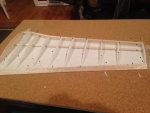Archimedian
Member
Howdy. What we are going to have here is a DTFB/purple foam/balsa composite build with full aluminum foil sheeting. Other features are aluminum tube for control surface hinges, aluminum tube suspension, and a belly exhaust vent.
Wingspan: 36"
Predicted weight: 400grams

The wing is built on top of a thick piece of corkboard that has been glued to a wooden board. The planform of the lower surface is cut and pinned to the work surface. I applied a wide strip of plastic tape underneath where I glued the leading and trailing edges.

A box is made on each side to house the aileron servos flush with the lower surface.

With the servo and servo wiring in place, the upper surface sheet is applied.

I attached the two wing halves before attaching the upper surface on one side. This was so i could add reinforcement to the centerline joint.

Small strips of purple insulation foam were glued to the wingtips. Now the wing can be shaped with sanding blocks. Once this is done, the ailerons are cut from the wing.

I dont have a detail of it now, but a 1/4 inch aluminum tube with some bits of concentric size tube, is used to make a hinge spanning the entire length of the aileron.
Before gluing the aileron and hinge to the wing, the wing and surface are completely sheeted with aluminum foil. Im using some extremely cheap foil because it is the thinnest i can find. I am adhering the aluminum using some epoxy mixed with glass balloons for lightening.
This process does not feel proper or pretty. The aluminum likes to wrinkle immediately with flexes in the airframe. Carry on though, and when large surfaces start to shine, you wont care about wrinkles. Be careful not to get grubby fingers on the aluminum. You cant sand it off. Use alcohol immediately.




Thats all for this post. Wing comes in at around 100grams, which i dont think is very bad. The fuselage contains more pink foam which will stack up the weight quickly.
Also, if anyone noticed, i completely forgot to incorporate my landing gear. This will get keyed into the spars later.
Wingspan: 36"
Predicted weight: 400grams

The wing is built on top of a thick piece of corkboard that has been glued to a wooden board. The planform of the lower surface is cut and pinned to the work surface. I applied a wide strip of plastic tape underneath where I glued the leading and trailing edges.

A box is made on each side to house the aileron servos flush with the lower surface.

With the servo and servo wiring in place, the upper surface sheet is applied.

I attached the two wing halves before attaching the upper surface on one side. This was so i could add reinforcement to the centerline joint.

Small strips of purple insulation foam were glued to the wingtips. Now the wing can be shaped with sanding blocks. Once this is done, the ailerons are cut from the wing.

I dont have a detail of it now, but a 1/4 inch aluminum tube with some bits of concentric size tube, is used to make a hinge spanning the entire length of the aileron.
Before gluing the aileron and hinge to the wing, the wing and surface are completely sheeted with aluminum foil. Im using some extremely cheap foil because it is the thinnest i can find. I am adhering the aluminum using some epoxy mixed with glass balloons for lightening.
This process does not feel proper or pretty. The aluminum likes to wrinkle immediately with flexes in the airframe. Carry on though, and when large surfaces start to shine, you wont care about wrinkles. Be careful not to get grubby fingers on the aluminum. You cant sand it off. Use alcohol immediately.




Thats all for this post. Wing comes in at around 100grams, which i dont think is very bad. The fuselage contains more pink foam which will stack up the weight quickly.
Also, if anyone noticed, i completely forgot to incorporate my landing gear. This will get keyed into the spars later.
Last edited:




















